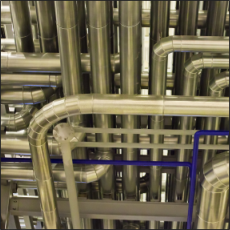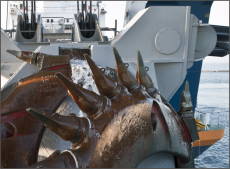Kruse Integration Automates Dredge – Sam Houston
The new automation package on the 30-inch dredge Sam Houston will control swing, ladder depth and stepping ahead, allowing the dredge to create a specific profile without constant operator input.
Jay Wise and other engineers from Kruse Integration are creating the system in conjunction with Chris Branas of Palm Beach Aggregates.
The Sam Houston is owned by Palm Beach Aggregates in Florida. One of the four owners is Ted Phillips, owner of general contractor Phillips and Jordan, Inc., who is managing the project. The other owners are Enrique Tomeu and Sam and Michael Klein.
The operation is 20 miles west of Palm Beach on State Road 80, and is about 3500 acres. The company recently purchased another 2000 acres that will also be dredged.
Using an existing programmable logic controller (PLC) on the dredge, Wise installed a terminal services-based graphical human machine interface (HMI) system, which will monitor and control swing speed and opposing winch torque based on vacuum, cutter current (horsepower), swing pressures and cutter rpm’s. A Hofer valve is interfaced into the system to control vacuum. Ladder depth and position will be controlled by interfacing the PLC and HMI systems with DredgePack software and Trimble RTK to create the customer’s profile of the pit.
In November, full automation of the dredging operation was a month away, awaiting modification of the winches so the system could control swing speed by controlling the torque on the winches.
When the Palm Beach County Water Authority purchased water storage rights from Palm Beach Aggregates, they specified the contours they required. There are six pits on the property, ranging in size from 200 acres to 111 acres. Final depth will be 45 to 50 feet.
The material – good quality shell and sand — is being pumped about three miles away to a 1245-acre development site, aided by two 4500 horsepower booster pumps. They are also filling an adjacent mined-out pit, which has been sold to Florida Power and Light.
At the discharge, GPS-equipped bulldozers move the material into the final elevation and contours.
The massiveness of the project and the need to create pre-determined profiles in the pits, as well as a desire to optimize efficiency, led the company to seek an automation and management solution. They contacted Kruse Integration in July of this year, and gave them the job.
By mid-November, the servers and terminals were installed, the touch screens were enabled, and reports on all aspects of the operation could be accessed. This included ability to view real-time operating information associated with the starboard and port winch torques, dredge pump, cutter, auxiliary equipment and boosters, as well as daily production reports, shift production reports, downtime reports specifying reasons for downtime, efficiency reports and production trends.
These reports are emailed from two industrial servers on the dredge to any owners and supervisors who require the information. In addition, with proper passwords and authorization, they can log into the system to view the dredge in operation, and query real time reports from anywhere in the world using a simple web browser.
Two industrial servers on the dredge run the automation software, Dredgepack and InSQL. A separate backup system is installed as a hedge against power or system failure.
Wise uses off-the-shelf hardware components, Wonderware automation software, and a Microsoft Server 2003 operating system. The non-proprietary nature of the components keeps costs down and allows for easy maintenance and replacement of parts.
For instance, Branas wanted the ability to access the system from various locations on the dredge. Rather than deal with separate computers, which were vulnerable to the vibration and other harsh conditions of a dredging operation, Wise used small “dumb” boxes called “thin-clients”, solid state units that talk to the terminal services server and displays on a touch screen.
The boxes are mounted in out-of-the-way places, but if one is damaged, it is easy and low cost to replace it.
There are two 19-inch touch screen displays in the lever room, the left one normally displaying the booster and other hydraulics, and the right one the main status.
A terminal on the below deck allows the engineers to view a main-tenance list for all the equipment based on hours of operation, as well as a daily maintenance list. Branas plans to add several more terminals at other locations on the dredge.
“If something fails, we can view the service intervals and analyze whether we need to change our maintenance procedures,” said Branas.
Also in the works is integration of the booster pumps into the operating system, using wireless Ethernet connection. Wise has completed automation on Booster 3, which is not yet in service. There are two boosters in use and the third will be added as the pipeline is lengthened. All the boosters will follow the dredge pump speed, biased by each individual booster intake pressure.
These pumps are now started and stopped manually by the dredge operator, in communication by radio with engineers monitoring the pumps – an exacting and difficult job, given the size and horsepower of the pumps.
“The engineers from Kruse Integration are all extraordinarily competent, knowledgeable and technically adept,” said Branas. “We have a high level of trust in them,” he said.
Palm Beach Aggregates is achieving 19 hours of operation per day and producing 1,000,000 to 1.3 million cubic yards per month. This is a result of good management and maintenance, helped by the components of the automation system installed so far.
These figures will be compared to production figures achieved after the dredge automation is completed.
Wise and Sassano have been creating automation systems for the pharmaceutical, food, beverage and other industries since 1981. In 1995, Wise was first asked to automate a dredge, and he brought with him the technology and methods he had been using to achieve an extremely high level of control in these other industries.
He saw that the dredging industry was not yet using these techniques, and began expanding into the industry, specifically in the sand and gravel sector, where he could automate a dredge and all elements of the processing plant, allowing owners to keep track of and increase production.
The growing demand for their services in the dredging industry has led Kruse Integration to view this as a primary market.












